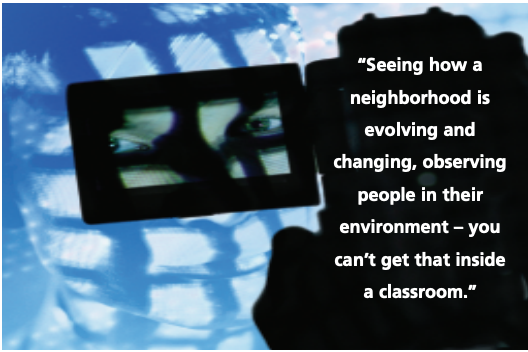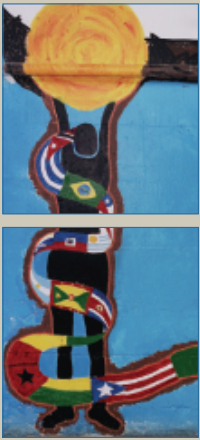
Students in Steve Harp’s documentary video
class last quarter broke down scenes of
digital film they have shot and tried to
figure out the best way to tell a manylayered story. Still, these students were not
just concerned with moving images they
can work with in a classroom. They focused
on what happened on the outside in the
lives of two communities they have gotten
to know through this class. During the
quarter, students completed short videos
for two community-based, not-for-profit
organizations: Lawndale Christian
Development Corporation (LCDC) and
Cambodian Association of Illinois. Harp’s
class, which has been offered at DePaul
four times since 2000, is one of many
community-based service learning classes
the Steans Center helped develop that
encourages learning based on real-life,
in-the-field experience.
Service learning
Harp says he learned about service learning before he even
taught this class through presentations and workshops offered by
the Steans Center. He notes that teaching a service learning class
is different than teaching other classes. “In some classes, we may
say ‘here’s the video camera, here’s how to make it work, here
are some exercises you need to do.’ In this class, the focus is more
on mastering skills by putting them into practice.” “I am more of
an advocate for students in this kind of class,” he adds. “In
traditional situations, I might say ‘here are the skills that need to
be mastered. In the end, I have to ask: ‘could you master these
things?’ Here, what we are really working toward is fulfilling a
service for a particular community group. What I’ve found is that
this is a way to work with an organization that is doing good
work – and to produce something about that organization.”
How students benefit
In the course of their service learning experience, Harp says that
students are introduced to a complex community they might not
otherwise have a chance to learn about. Last quarter, the rich and
triumphant stories of two communities offered a dynamic living
history for students to film.

Located on Chicago’s west side in the economically challenged
community of Lawndale, LCDC has grown into a leader in the
realm of neighborhood-based housing development and also
offers a range of programs to community residents. In the Albany
Park neighborhood on Chicago’s north side, the Cambodian
Association of Illinois has emerged as a vital source of support for
generations of people affected by the genocide in Cambodia in
the early 1970s. The organization serves more than 7,000 refugee
and immigrant Cambodians in the Chicago area. Students in the
class not only had a chance to learn about these communities,
they worked with these organizations to complete films that
express a vision of that community. Harp says students engaged
in a collaborative process through which they have learned how
to work with community-based groups whose stories are the
subject of these videos.
Sangini Brahmbhatt, a senior in graphic design who worked on
the LCDC video, suggested there is value to understanding how
to meet the needs of an organization in a professional way while
learning new skills. “It’s really about knowing what they want,”
she says, “and what we can provide.” In this case, she said, the
video will include interviews and other segments that focus on
the group’s real estate, education and community organizing
efforts. Brahmbhatt echoed the thoughts of many others when
asked about the benefits of the class.
 Video Class: Value to the community
Video Class: Value to the community “It’s a great learning experience,” she says. “Seeing
how a neighborhood is evolving and changing,
observing people in their environment – you can’t get
that inside a classroom.” For community groups
working with the class, these short videos can be used
as a tool to help tell their story.

Brady Harden,
Executive Director of Inner Voice, which provides
services to the homeless in Chicago, says his
organization has used a video made by DePaul
students in a number of ways. Harden says that Inner
Voice showed the video at a recent fundraising event
and that it will also become part of the organization’s
website. “I also pop in the video when I meet people
for the first time at Inner Voice,” he says. “It’s detailed
enough to cover the issue of the homeless and our
response to it, but also tells our story without boring
anybody.”
Meanwhile, Kristen Oxendale, Resource Development
Manager for LCDC, says the growing organization
would like to use the film for marketing purposes.
“The only video we have for our organization was
done in 1992,” she says. “It’s not something we can
use anymore. We’re hoping to use the video students
made to help us do volunteer recruiting, inform
funders about what we do and for other purposes.”
Harp suggests the videos can benefit participating
organizations in a number of ways. “The obvious
benefit is that they get this product that costs them
nothing but a little bit of time,” he says. “I also think
it helps break down barriers between community
groups and what some would call ‘the ivory tower’ of
the academic world.”
Aside from the final product, Harp says he has been
pleased to see how students have met the challenge
of reaching out to new communities and establishing
a dialogue with local organizations. “I’ve been happy
with the way students have responded,” he says.
“There’s a real connection between what they are
doing and the needs of these groups. I think the class
has helped students to kind of open up – and think
about what’s outside of their experience.”